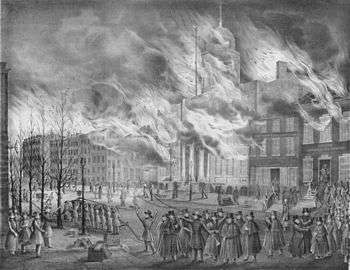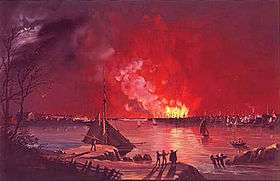Great Fire of New York
The Great Fire of New York (1835) was one of three fires that did extensive damage to New York City in the 18th and 19th centuries. The fire covered 17 city blocks and destroyed hundreds of buildings. The fire killed two people and cost an estimated $200 million in property damage.
Background
By 1835, New York City was the premier American city and its financial prowess surpassed that of Philadelphia or Boston. The opening of the Erie Canal ten years earlier connected New York to raw materials and commercial interests in the Midwest and allowed the city to rise to prominence as a market hub. Over half of the country’s exports left through New York harbor while more than a third of American imports arrived there. Insurance companies, investment firms, real estate companies and others made New York their home.
As the city expanded northward and its economic significance increased, fire was a major concern. Insurance companies worried that a large fire could sap their resources. The mayor and common council members held stock in or were board members of many fire insurance firms. City officials made efforts to build more watch towers and hire more watchmen. One serious impediment to firefighting was the lack of a reliable water source. By 1835, little had been done to solve the city’s water problem. The city’s residents as well as its firefighters relied on neighborhood wells, forty fire cisterns and a reservoir located at 13th Street and the Bowery. Cholera outbreaks in 1832 and 1834 hastened the city’s plans for building the Croton Reservoir, which would bring clean water from Westchester County into the city.
The fire department’s growth in the 1820s and 1830s had not kept pace with the growth of the city. The city’s population had swelled by an additional 145,000 in the past decade, but the department had added only about 300 firemen. 1,500 firemen, 55 engines, 6 ladder companies and 5 hose carts could not protect the city. Throughout the summer and fall of 1835, the department had fought numerous fires. On December 14th, the entire fire department – 1500 strong – had spent the freezing, miserable evening fighting two large fires, which destroyed thirteen buildings and two shops. The city’s fire cisterns were nearly empty and its firefighting force exhausted when disaster struck.[1]
Fire
The fire began on the evening of December 16, 1835 in a five-story warehouse at 25 Merchant Street, now known as Beaver Street,[2] at the intersection of Hanover Square, Manhattan[3] and Wall Street. As it spread, gale-force winds blowing from the northwest towards the East River spread the fire. At the time of the fire, major water sources including the East River and the Hudson River were frozen solid in temperatures as low as −17 °F (−27 °C). The conflagration was visible from Philadelphia, approximately 80 miles away.
Firefighters were forced to drill holes through ice to access water, which later froze in the hoses and pipes. Attempts were made to deprive the fire of fuel by demolishing surrounding buildings, but at first there was insufficient gunpowder in Manhattan. Later in the evening, Marines returned with gunpowder from the Brooklyn Navy Yard and began to blow up buildings in the fire's path.
An investigation did not assign blame and reported that a burst gas pipe, ignited by a coal stove was the initial source.
Damage
The fire covered 50 acres (200,000 m2), in 17 blocks and had destroyed between 530 and 700 buildings. This part of the city is now known as Coenties Slip, an area between the East River and Maiden Lane in the north and William Street in the west.[4] The estimated damage at the time was valued at twenty million dollars, while two people were killed.[5]
According to an account published in the History of New York:,[6] "many of the stores destroyed in the fire were new, with iron shutters and doors and copper roofs. When they burned, witnesses described appearance of immense iron furnaces in full blast. The heat at times melted the copper roofing and the liquid ran off in great drops. A gale blew towards the East River. Wall after wall was heard tumbling like an avalanche. Fiery tongues of flame leaped from roof and windows along whole streets and seemed to be making angry dashes at each other. The water of the bay looked like a vast sea of blood. The bells rang for a while and then ceased. Both sides of Pearl Street and Hanover Square were at the same instant engulfed in flames."
Another report gave a colorful account of the damage:
A most awful conflagration occurred at New York on the 15th of December, by which 600 buildings were destroyed, comprising the most valuable district of the city, including the entire destruction of the Exchange, the Post Office and an immense number of stores. The fire raged incessantly for upwards of fifteen hours. The shipping along the line of wharfs suffered considerably; several vessels were entirely destroyed. The property consumed is estimated at 20,000,000 dollars.[7]
It also praised the resilience of the population:
In this midst of this terrible visitation, however, it is consolatory to see the elastic energy of the people. Instead of wasting their time in despondency over this frightful desolation, the whole population seems to on the alert to repair the mischief.[7]
Reconstruction
Recovery meant improved buildings, which would require financing. Negotiations were swiftly undertaken and the cooperation of banks was crucial in preventing an economic disaster:
Plans of rebuilding on an improved scale and modes of borrowing money for that purpose, on sound securities, are under arrangement. The energy of the inhabitants and the ready manner in which the banks had offered to make advances to the different insurance companies, as well as to private individuals, would avert, it was expected, a commercial crisis.[7]
The fire bankrupted several insurance companies, slowing the processing of claims. The fire occurred in the middle of an economic boom caused by the opening of the Erie Canal. The destroyed wooden buildings were quickly replaced by larger stone and brick ones that were less prone to burn. The fire also prompted construction of a new municipal water supply, now known as the Old Croton Aqueduct and a reform and expansion of the fire service. 23 of New York's 26 insurance companies went out of business[8] and Hartford, Connecticut based insurers came to dominate the New York fire insurance market. Today, Hartford is still known as the "Insurance Capital of the World".
See also
- Great Fire of New York (1776)
- Great Fire of New York (1845)
- Great Fire of London
- Great Fire of Brisbane
- 1871 Great Chicago Fire
- Great Fire of Turku
References
- ↑ "Virtual New York City". Virtual New York City. CUNY New Media lab. Retrieved 10 February 2016.
- ↑ oldstreets.com
- ↑ "Heroes of Ground Zero: FDNY - A History]". Retired Site - PBS Programs - PBS.
- ↑ Exhibit Details Devastation of Years Past
- ↑ "New York's Great Fire of 1835".
- ↑ "History of the City of New York: Its Origin, Rise, and Progress".
- 1 2 3 Gentleman's Magazine, by "Sylvanus Urban," Vol. V, New Series, January–June 1836 (London: William Pickering, John Bowyer Nichols & Son, 1836), p. 196. Accessed 19 March 2012.
- ↑ "THE GREAT FIRE OF 1835". New York Post. 16 November 2007.
External links
- "Chapter 18: The Great Conflagration of 1835", History of the Fire Department of the City of New York.
Coordinates: 40°42′25″N 74°00′36″W / 40.707°N 74.010°W

